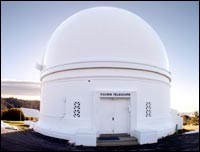World’s largest astronomical CCD camera installed on Palomar Observatory telescope

Oschin Telescope Dome
The world’s largest astronomical camera has been installed on Palomar Observatory’s 48-inch Oschin Telescope in California. This telescope has been working to improve our understanding of the universe for nearly 55 years. The new upgrade will help it to push the limits of the unknown for years to come.
The new camera is known as QUEST (Quasar Equatorial Survey Team). Designed and built by astrophysicists at Indiana and Yale universities, QUEST recently “saw” its first starlight and is now scanning the sky.
In 2001, an electronic camera known as the Near-Earth Asteroid Tracker was installed in the Oschin Telescope. The camera, which employed a charge-coupled device (CCD) to detect light, was very successful. During its tenure on Palomar, the NEAT team discovered 189 near-Earth asteroids and 20 comets.
A charge-coupled device is a light-sensitive integrated circuit that stores and displays the data for an image in such a way that each pixel in the image is converted into an electrical charge whose intensity is related to a color in the visual spectrum. The QUEST camera has an array of 112 CCDs.
The Oschin Telescope had to undergo some major changes to accommodate the QUEST camera. Under the oversight of Richard Ellis, director of Palomar Observatory, this process was guided by Robert Thicksten and Hal Petrie of the California Institute of Technology. The delicate installation of the camera and its electronics inside the telescope was handled by Mark Gebhard (Indiana University), William Emmet (Yale University) and David Rabinowitz (Yale University). The camera’s readout electronics were constructed in the Physics and Astronomy departments at Indiana University by Gebhard and Brice Adams, under the direction of James Musser, Kent Honeycutt and Stuart Mufson. The hardware for the QUEST camera was constructed by the Yale University Physics Department under the direction of Charles Baltay.
In addition to the usual point-and-shoot mode, the new camera is designed to work in the drift scan mode. The telescope is pointed at the sky but does not move to counteract the rotation of the Earth. Instead, various objects in the sky gradually drift across the field of view at the same rate as the computer records data from the CCDs, producing photographs that are long strips of the sky. Astronomers will use these photographic slices of the sky to look for quasars, supernovae, asteroids and more.
Last year, Caltech astronomers Chad Trujillo and Mike Brown used the NEAT camera on the Oschin Telescope to find the distant world known as Quaoar. Quaoar is about half the size of Pluto, making it the biggest object to be found in our solar system since Pluto was discovered in 1930. Quaoar is the largest known member of the Kuiper Belt, a swarm of thousands of icy objects that orbit beyond Neptune. Brown is convinced there are more big Kuiper Belt objects, possibly as big as the planet Mars, and he will use QUEST to look for them.
Other scientists plan to use the camera to find objects that might be quasars. Quasars are the very bright cores of distant galaxies that are thought to contain supermassive black holes. They are among the most luminous objects in the universe. Any quasar candidates that are found with the Oschin Telescope will be looked at again with Palomar’s 200-inch Hale Telescope. Those objects that the Hale Telescope confirms to be quasars will be the targets of more detailed study with one of the 10-meter Keck Telescopes in Hawaii.
A similar approach will be used as distant galaxies are probed in a search for exploding stars known as supernovae. The QUEST camera will do the survey work, suspected supernovae will be looked at with the Hale Telescope, and supernovae of the right type will be scrutinized at one of the Keck Telescopes. Astronomers will use data from these exploding stars to try to confirm that the universe is accelerating as it expands.
Palomar Observatory, owned and operated by the California Institute of Technology and located in north San Diego County, Calif., supports the research of Caltech faculty and students, and that of researchers at Caltech’s collaborating institutions: Indiana University, Cornell University, Yale University and the Jet Propulsion Laboratory.
Contact: James Musser, at +1-812-855-9933, musser@bigbang.astro.indiana.edu
or Kent Honeycutt at +1-812-855-6916, honey@astro.indiana.edu
Media Contact
More Information:
http://www.indiana.eduAll latest news from the category: Physics and Astronomy
This area deals with the fundamental laws and building blocks of nature and how they interact, the properties and the behavior of matter, and research into space and time and their structures.
innovations-report provides in-depth reports and articles on subjects such as astrophysics, laser technologies, nuclear, quantum, particle and solid-state physics, nanotechnologies, planetary research and findings (Mars, Venus) and developments related to the Hubble Telescope.
Newest articles

NASA: Mystery of life’s handedness deepens
The mystery of why life uses molecules with specific orientations has deepened with a NASA-funded discovery that RNA — a key molecule thought to have potentially held the instructions for…

What are the effects of historic lithium mining on water quality?
Study reveals low levels of common contaminants but high levels of other elements in waters associated with an abandoned lithium mine. Lithium ore and mining waste from a historic lithium…

Quantum-inspired design boosts efficiency of heat-to-electricity conversion
Rice engineers take unconventional route to improving thermophotovoltaic systems. Researchers at Rice University have found a new way to improve a key element of thermophotovoltaic (TPV) systems, which convert heat…



